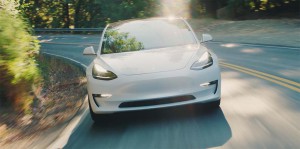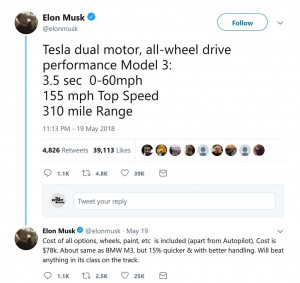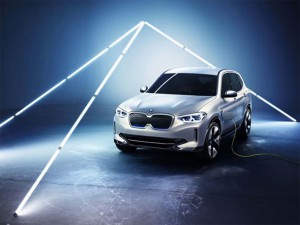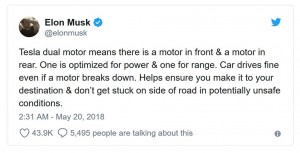
Tesla CEO Musk claims the performance Model 3 will not only be faster, but handle better than the BMW M3.
Despite a painfully slow ramp-up of production, Tesla is planning to add a new high-performance version of its Model 3 sedan that CEO Elon Musk claims will be “quicker than a BMW,” and be able to “beat anything in its class on a track.”
In a series of tweets over the weekend, Musk fleshed out details about the all-wheel-drive electric vehicle, noting that it will launch from 0 to 60 in 3.5 seconds, top out at an Autobahn-burning 155 mph, and still yield 310 miles per charge – at least when driven a bit less aggressively. But the yet-unnamed performance version of the Model 3 will also cost $78,000, or about twice as much as a base version of the electric sedan.
That steep jump actually isn’t entirely out of line, at least when comparing to the likes of a BMW 3-Series sedan. The German sports sedan starts at $34,900, around the same figure as a Model 3 before factoring in the $7,500 federal tax credit. The BMW M3 starts at $66,500, though appears to have less standard equipment than the Model 3 performance version. The Tesla includes AWD, for example, an otherwise $5,000 option.
(Despite record losses, Wall Street remains upbeat on Tesla. Click Here to learn why.)
South African-born Musk took a few shots at Tesla’s German rivals in a series of tweets, among other things, bragging that the new Model 3 version will “beat anything in its class.” In fact, he declared it will be “15% quicker & with better handling” than the M3.
 Turnabout is fair play, it seems. In recent months, Tesla has taken some hits from BMW and other German manufacturers who are, collectively, planning to roll out a wave of new electric vehicles of their own over the next several years.
Turnabout is fair play, it seems. In recent months, Tesla has taken some hits from BMW and other German manufacturers who are, collectively, planning to roll out a wave of new electric vehicles of their own over the next several years.
That includes the new EQA Mercedes-Benz last week said it will build at a plant in France, as well as the Porsche Mission E, basically an electric 911, an all-electric version of the Audi Q5, and an assortment of battery-electric BMWs.
(For more on Mercedes’ new BEV production plant, Click Here.)
Tesla has been dribbling out information about the performance Model 3 in recent weeks, among other things noting it will have twin electric motors, one on each axle. While they will be able to work together to offer what is sometimes referred to as “through-the-road all-wheel-drive,” they also will be able to operate independently, Musk noted in one tweet. That means that if one motor fails, he explained, the other will “ensure you make it to your destination & don’t get stuck on side of road in potentially unsafe conditions.”
It’s not been revealed if the performance Model 3 will feature the same switchable “Ludicrous Mode” found on the older Model S and Model X electric vehicles, or will simply be in performance mode at all times.
Another question is whether Tesla has addressed issues that limit the performance capabilities of those older products. While the Model S P100D can, in Ludicrous Mode, hit 60 in barely 3 seconds, it can only do so a handful of times on a fully charged battery. And the vehicle can’t really handle much time on a track before its motors and batteries overheat and it goes into a low-performance mode.

BMW plans to take a shot back at Tesla with a series of new BEVs. The iX3 concept it revealed in Beijing last month is shown here.
Porsche, BMW and other Tesla competitors have promised to take steps to prevent those problems.
There will be two versions of the performance Model 3, with a second, apparently single-motor variant lacking all-wheel-drive and cutting its 0 to 60 times to around 4.5 seconds. Its top speed will be a slightly lower 140 mph. The price has not been disclosed.
When the new version of the Model 3 will be added is unclear, though there are plenty of folks also waiting for the promised base version of the electric sedan. So far, Tesla has focused on fairly well-equipped versions averaging around $45,000.
It can use the added revenue considering it remains well behind its original production targets for the Model 3. After a deathly slow launch it only got up to about 2,000 a week by the end of the first quarter, a 20% shortfall from its 2,500 target.
Musk has promised to push that to around 6,000 by the end of the current quarter. The blog Electrek last week acquired a leaked e-mail Musk sent to employees suggesting it is “quite likely” it can now hit 500 of the compact sedans a day. With Tesla’s Fremont, California plant on maximum overtime that would work out to 3,500 a week. The long-term goal is to hit 10,000, however.
(Tesla Model S was running in Autopilot mode at time of most recent crash. Click Here for the latest.)
 The production problems led Tesla to report its worst-ever loss during the first quarter and analysts aren’t much more optimistic about what will happen for the April-June period. While Tesla stock has rebounded in recent weeks, there are still a number of skeptics and even some more bullish observers question Musk’s assertion that Tesla won’t need to raise more capital this year. Goldman Sachs, in fact, expects the company to need another $10 billion in equity by 2020.
The production problems led Tesla to report its worst-ever loss during the first quarter and analysts aren’t much more optimistic about what will happen for the April-June period. While Tesla stock has rebounded in recent weeks, there are still a number of skeptics and even some more bullish observers question Musk’s assertion that Tesla won’t need to raise more capital this year. Goldman Sachs, in fact, expects the company to need another $10 billion in equity by 2020.
Tesla faces a variety of other issues, including a number of lawsuits, charges leveled by the National Labor Relations Board that it fired 1,000 workers to blunt a unionization drive in Fremont, and a series of investigations by federal regulators looking into a series of recent crashes. Several of those involve Tesla’s semi-autonomous Autopilot technology.
Musk has a history of releasing upbeat tweets when Tesla faces problems and by focusing on new products like the performance Model 3, as well as the upcoming Model Y SUV, the next-generation Roadster and the electric Semi, he has been able to retain a loyal following and keep Tesla’s investors largely in the bullish category.

Fast electric cars: just the ticket for saving the planet.